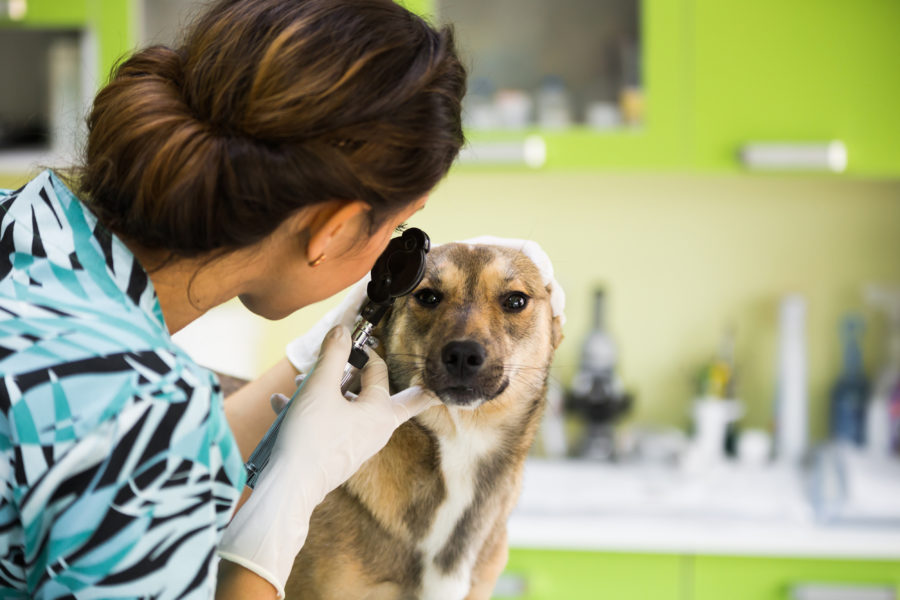Cataracts in dogs have many causes – aging, diabetes, genetic predisposition and more. While surgery is the only treatment, there are ways to help prevent or slow the progression of this common condition.
 As dogs age, many develop cataracts. Their eyes start to look cloudy, and their vision begins to decline. Canine cataracts also have other causes, including diabetes mellitus, genetic predisposition, progressive retinal atrophy, and exposure to the sun’s UV rays, as well as metabolic and nutritional imbalances. So it’s important to consider your dog’s eye health throughout his life, especially as he gets older. In this article, we’ll look at what cataracts are, why they form, and how we can help prevent them or slow their progression.
As dogs age, many develop cataracts. Their eyes start to look cloudy, and their vision begins to decline. Canine cataracts also have other causes, including diabetes mellitus, genetic predisposition, progressive retinal atrophy, and exposure to the sun’s UV rays, as well as metabolic and nutritional imbalances. So it’s important to consider your dog’s eye health throughout his life, especially as he gets older. In this article, we’ll look at what cataracts are, why they form, and how we can help prevent them or slow their progression.
How cataracts develop
The eye’s crystallin lens is an immortal organ, made up of compressed layers of special transparent proteins called “crystallins”. The lens grows throughout life, with the oldest layers in the center (nucleus).
Lens proteins are hidden from the immune system by the lens capsule. If these proteins leak from the lens, the immune system detects them, misinterprets them as being foreign, and attacks the eye. This leads to lens-induced uveitis (LIU), which can have devastating consequences for vision and even survival of the eye.
Proteins in the body typically last no longer than a few days. However, lens proteins become terminally modified and entombed inside lens fiber cells; they must “live forever” in an insoluble state in order to retain lens transparency and vision. A cataract occurs through the activation of oxidative mechanisms that result in the aggregation of damaged lens proteins.
The lens is exposed to profound oxidative stressors, especially sunlight. Just as raw egg whites turn opaque when cooked, due to protein breakdown, the clear lens of the eye also turns white when its proteins break down.
Cooked egg whites cannot be uncooked, and cataracts cannot be reversed. There is no non-surgical way to treat cataracts; only surgery will sufficiently address vision impairment. This means it’s critical to prevent cataract formation and progression.
Slowing the formation and progression of cataracts
Once a cataract begins, many genes in the lens become activated or down-regulated. These genes include telomerase, estrogen receptor alpha, and protein kinase B (pAkt). Furthermore, any stage of cataract can cause LIU, which further exacerbates progression. The ultimate outcome is a progressing cataract, although the rate of progression is unpredictable. Controlling LIU is imperative for diminishing the risk of secondary glaucoma and/or retinal detachment.
Many antioxidants possess anti-inflammatory properties and may be helpful in controlling LIU. These include grapeseed extract, lutein, astaxanthin, Omega-3 fatty acids, alpha lipoic acid, curcumin and green tea extract.
The lens has an arsenal of protective strategies to minimize damage from oxidative stress, including antioxidants such as ascorbate to help keep proteins soluble and clear. The most important lens antioxidant system is glutathione in its reduced state. Low glutathione levels diminish lens protection and cause cataracts due to damage to DNA, cell components and proteins. Additionally, dogs with cataracts have lower plasma ascorbate levels than normal dogs.
Dietary modulation of the pathways that promote cataract formation may slow or inhibit the process. Micronutrients with antioxidant properties can potentially stop oxidative damage, either by attenuating or repairing damaged lens proteins. Antioxidants such as lutein, zeaxanthin, astaxanthin, grapeseed extract, and vitamins C and E have been shown to protect the lens against a variety of oxidative stressors. This antioxidant protection reduces reactive oxygen species, lessens lipid peroxidation, and thus decreases the risk of cataract development or progression. Lutein and zeaxanthin are oxycarotenoids that selectively accumulate in the lens; supplementation in cultured lens epithelial cells protects lens lipid, protein and DNA from oxidative damage. Grapeseed extract inhibits pathways associated with cataract formation.
Supplementation with these antioxidants may especially benefit dogs at risk for genetic cataract formation, or those in the early stages of cataract development. Even if cataracts progress in affected dogs, specific antioxidant supplementation should continue to help make these dogs better candidates for cataract surgery, and to aid in limiting the damaging effects of LIU even if surgery is not chosen.
Supporting vision health in dogs includes lens-healthy strategies such as feeding a low fat diet with high quality protein and carbohydrate sources; reducing food sources that trigger systemic inflammation; maintaining a healthy weight; and reducing chronic exposure to sunlight. In dogs predisposed to developing cataracts, lifetime supplementation with specific antioxidants for lens support will help maintain optimal vision health.








